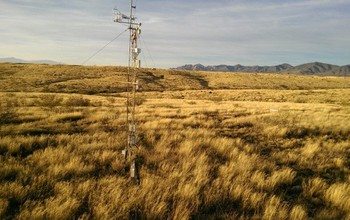Grasslands across North America will face higher summer temperatures and widespread drought by the end of the century, according to a new study.
But those negative effects in vegetation growth will be largely offset, the research predicts, by an earlier start to the spring growing season and warmer winter temperatures.
Led by ecologists Andrew Richardson and Koen Hufkens of Harvard University, a team of researchers developed a detailed model that enables predictions of how grasslands from Canada to Mexico will react to climate change.
The model is described in a paper published today in the journal Nature Climate Change.
New insights into climate change effects on grasslands
“This research brings new insights into predicting future climate-driven changes in grasslands,” says Elizabeth Blood, program director in the National Science Foundation’s Division of Environmental Biology, which funded the research. “The results show that annual grassland cover and productivity will increase despite drought-induced reductions in summer productivity and cover.”
Ultimately the growing season gets split into two parts, Hufkens said. “You have an earlier spring flush of vegetation, followed by a summer depression where the vegetation withers, then at the end of the season, you see the vegetation rebound again.”
Adds Richardson, “The good news is that total grassland productivity is not going to decline, at least for most of the region. But the bad news is that we’re going to have this new seasonality that is outside of current practices for rangeland management — and how to adapt to that is unknown.”
To understand the effects of climate change on grasslands, the scientists created a model of the hydrology and vegetation of the region. They used data from the PhenoCam Network, a collection of some 250 Internet-connected cameras that capture images of local vegetation conditions every half-hour.
Using 14 sites that represent a variety of climates, the biologists ran the model against a metric of “greenness” to ensure that it could reproduce results in line with real-world observations.
“These were sites from across North America, from Canada to New Mexico and from California to Illinois,” Richardson said. “We used the greenness of the vegetation as a proxy for the activity of that vegetation. We were then able to run the model into the future.”
The region was divided into thousands of 10 square-kilometer blocks, allowing researchers to spot important differences in the response to climate change.
“That allows us to look at how patterns emerge in different areas,” Hufkens said.
Importantly, Richardson said, the model also uses a daily rather than monthly time step.
Changing seasonal patterns bring challenges
“Grasslands are different than forests in that they respond very quickly to moisture pulses,” said Richardson. “This model takes advantage of that — by running at a daily time scale, it can better represent changing patterns.”
The changing conditions could present challenges for farmers, ranchers and others who rely on predictable seasonal changes to manage the landscape.
“These shifting seasons will present new tests for management practices,” Richardson cautioned.
For grasslands, the increases in production and losses due to higher summer temperatures largely balance out, Hufkens said.
Although the results suggest that climate change may have some positive effects, both Hufkens and Richardson warned that they are the result of a delicate balance.
“It’s getting more arid and that’s causing more intense summer droughts, but because of a changing seasonality, vegetation growth is shifting,” said Richardson.
The negative effects of drought on ecosystem production can be offset, he believes. “But that raises new questions about appropriate management responses,” he said.
“Relying on this increase in productivity, or expecting that climate change will have long-term benefits because of results like this, is like playing the lottery — the odds are not very good.”
If our reporting has informed or inspired you, please consider making a donation. Every contribution, no matter the size, empowers us to continue delivering accurate, engaging, and trustworthy science and medical news. Independent journalism requires time, effort, and resources—your support ensures we can keep uncovering the stories that matter most to you.
Join us in making knowledge accessible and impactful. Thank you for standing with us!

